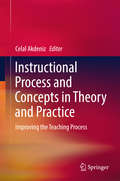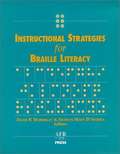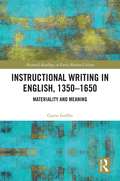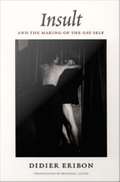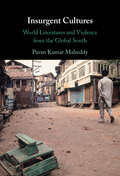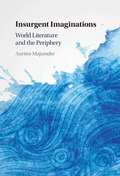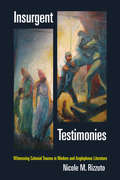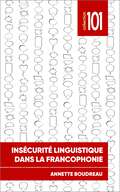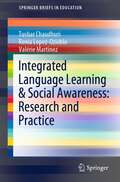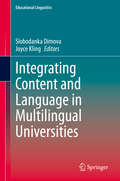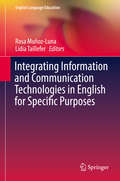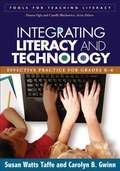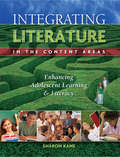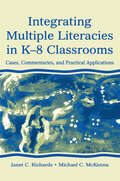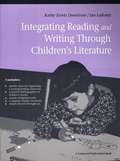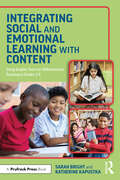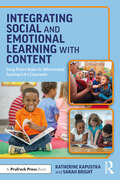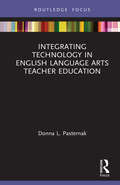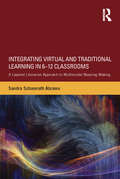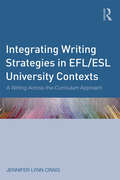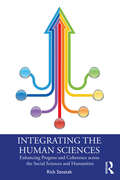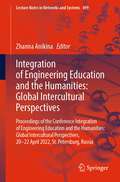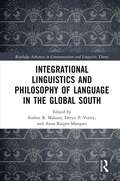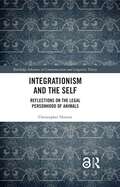- Table View
- List View
Instructional Process and Concepts in Theory and Practice: Improving the Teaching Process
by Celal AkdenizThis book offers an accessible, practical and engaging guide that provides sample instructional activities supported by theoretical background information, with a focus on the nature of the instructional process in relation to several variables. It approaches instructional models, strategies, methods, techniques, tactics and planning from a new perspective and shares effective tips to help readers better understand the instructional process and its theoretical elements. The book addresses the following questions:What is the nature of the instructional process?What are the classifications of contemporary models and strategies developed within the instructional process?Which groups yield the most effective methods and techniques, and how can they best be practically implemented?What are the instructional tactics teachers need to take into consideration, in which groups are they collected, and which tips can help us employ each tactic?Additionally, readers can adapt the book’s ready-to-use sample activities to their own educational settings. Overall, this book offers an enlightening discussion on contemporary practices related to the teaching process, a broad and holistic theoretical framework, and an ideal reference source for all students and scholars who are interested in the educational sciences.
Instructional Strategies for Braille Literacy
by Diane P. Wormsley Frances M. D'AndreaOffers instructors specific, practical strategies for the teaching of Braille reading and writing. Chapters discuss general guidelines and strategies; fostering emergent learning; making the transition from print to Brail teaching Braille to students with special needs, and to students who speak English as a second langua assessing the literary skills of students who are blind or visually impaired; and technology and Braille. Annotation copyrighted by Book News, Inc. , Portland, OR
Instructional Writing in English, 1350-1650: Materiality and Meaning (Material Readings in Early Modern Culture)
by Carrie GriffinExploring the nature of utilitarian texts in English transmitted from the later Middle Ages to c. 1650, this volume considers textual and material strategies for the presentation and organisation of written knowledge and information during the period. In particular, it investigates the relationship between genre and material form in Anglophone written knowledge and information, with specific reference to that which is usually classified as practical or 'utilitarian'. Carrie Griffin examines textual and material evidence to argue for the disentangling of hitherto mixed genres and forms, and the creation of 'new' texts, as unexplored effects of the arrival of the printing press in the late fifteenth century. Griffin interrogates the texts at the level of generic markers, frameworks and structures, and studies transmission and dissemination in print, the nature of and attitudes to printed books, and the audiences they reached, in order to determine shifting attitudes to books and texts. Learning and Information from Manuscript to Print makes a significant contribution to the study of so-called non-literary textual genres and their transmission, circulation and reception in manuscript and in early modern printed books.
Insult and the Making of the Gay Self
by Didier EribonA bestseller in France following its publication in 1999, Insult and the Making of the Gay Self is an extraordinary set of reflections on "the gay question" by Didier Eribon, one of France's foremost public intellectuals. Known internationally as the author of a pathbreaking biography of Michel Foucault, Eribon is a leading voice in French gay studies. In explorations of gay subjectivity as it is lived now and as it has been expressed in literary history and in the life and work of Foucault, Eribon argues that gay male politics, social life, and culture are transformative responses to an oppressive social order. Bringing together the work of Jean-Paul Sartre, Pierre Bourdieu, Judith Butler, and Erving Goffman, he contends that gay culture and political movements flow from the need to overcome a world of insult in the process of creating gay selves. Eribon describes the emergence of homosexual literature in Britain and France at the turn of the last century and traces this new gay discourse from Oscar Wilde and the literary circles of late-Victorian Oxford to Andr Gide and Marcel Proust. He asserts that Foucault should be placed in a long line of authors--including Wilde, Gide, and Proust--who from the nineteenth century onward have tried to create spaces in which to resist subjection and reformulate oneself. Drawing on his unrivaled knowledge of Foucault's oeuvre, Eribon presents a masterful new interpretation of Foucault. He calls attention to a particular passage from Madness and Civilization that has never been translated into English. Written some fifteen years before The History of Sexuality, this passage seems to contradict Foucault's famous idea that homosexuality was a late-nineteenth-century construction. Including an argument for the use of Hannah Arendt's thought in gay rights advocacy, Insult and the Making of the Gay Self is an impassioned call for critical, active engagement with the question of how gay life is shaped both from without and within.
Insurgent Cultures: World Literatures and Violence from the Global South
by Pavan Kumar MalreddyMoving beyond the normative frames of terrorism and counter-terrorism, this book shows how world literatures from the Global South can be used to examine the multiple modalities of violence that pervade contemporary world politics, such as communalism, factionalism, peasant wars, banditry, nationalist struggles, resource wars and acts of vengeance. The comparative approach of this book enables a theoretical realignment of insurgency from the mobilization of violence for grand, mythic, and ideological causes – as seen through the eyes of the state – to the violence for small causes, namely, the splintered violence conjured under conceptual rubrics such as divine violence, intimate violence, routine violence, everyday violence, inherited violence, and subterranean violence. Analyzing novels, autobiographies, journalistic accounts from key regions, such as Nigeria, Myanmar (Burma), India, and the Middle East, Insurgent Cultures provides a new understanding of the narratives of violence in the Global South. This title is also available as Open Access on Cambridge Core.
Insurgent Imaginations: World Literature and the Periphery
by Auritro MajumderThis book argues that contemporary world literature is defined by peripheral internationalism. Over the twentieth and twenty-first centuries, a range of aesthetic forms beyond the metropolitan West - fiction, memoir, cinema, theater - came to resist cultural nationalism and promote the struggles of subaltern groups. Peripheral internationalism pitted intellectuals and writers not only against the ex-imperial West, but also against their burgeoning national elites. In a sense, these writers marginalized the West and placed the non-Western peripheries in a new center. Through a grounded yet sweeping survey of Bengali, English, and other texts, the book connects India to the Soviet Union, China, Vietnam, Latin America, and the United States. Chapters focus on Rabindranath Tagore, M. N. Roy, Mrinal Sen, Mahasweta Devi, Arundhati Roy, and Aravind Adiga. Unlike the Anglo-American emphasis on a post-national globalization, Insurgent Imaginations argues for humanism and revolutionary internationalism as the determinate bases of world literature.
Insurgent Testimonies: Witnessing Colonial Trauma in Modern and Anglophone Literature
by Nicole M. RizzutoDuring the second half of the nineteenth century and the first half of the twentieth, insurgencies erupted in imperial states and colonies around the world, including Britain’s. As Nicole Rizzuto shows, the writings of Ukrainian-born Joseph Conrad, Anglo-Irish Rebecca West, Jamaicans H. G. de Lisser and V. S. Reid, and Kenyan Ng gi wa Thiong’o testify to contested events in colonial modernity in ways that question premises underlying approaches in trauma and memory studies and invite us to reassess divisions and classifications in literary studies that generate such categories as modernist, colonial, postcolonial, national, and world literatures.Departing from tenets of modernist studies and from methods in the field of trauma and memory studies, Rizzuto contends that acute as well as chronic disruptions to imperial and national power and the legal and extra-legal responses they inspired shape the formal practices of literatures from the modernist, colonial, and postcolonial periods.
Insécurité linguistique dans la francophonie (Collection 101)
by Annette BoudreauVous êtes-vous déjà demandé si vous parliez le français qui convient ? Avez-vous déjà eu honte de votre manière de parler ou de la manière de parler des gens de votre communauté ? Si oui, cet ouvrage vous aidera à mieux comprendre les mécanismes qui régissent ces comportements langagiers. L’insécurité linguistique, fréquente dans la francophonie, serait issue de la façon dont la langue française s’est développée, de l’idée d’une norme unique et d’une vision unitaire et uniforme du français, qui perdure et qui est à la base d’exclusions sociales. Cet ouvrage décrit le phénomène de l’insécurité linguistique, son histoire, ses manifestations, et ses retentissements. Il porte précisément sur l’insécurité linguistique dans la francophonie et puise ses exemples dans la francophonie canadienne.Cet essai propose une analyse des principales manifestations du continuum qu’est l’insécurité linguistique, de l’hypercorrection – sa forme la plus légère – à la honte et au silence. Il explore les liens entre insécurité linguistique et diglossie, soit les rapports de domination entre groupes de personnes qui parlent des langues différentes ou entre personnes qui parlent la même langue. Enfin, il examine le rôle joué par les idéologies linguistiques et sociales dans la construction identitaire, idéologies masquées qui régissent les discours et qui agissent sur les comportements langagiers.
Integrated Language Learning & Social Awareness: Research and Practice (SpringerBriefs in Education)
by Tushar Chaudhuri Renia Lopez-Ozieblo Valérie MartinezThis book reports on and analyses the Integrated Language Learning & Social Awareness Project, a unique project in the field of Foreign Language Learning and Telecollaboration till now in the world. It takes the existing research on telecollaborative learning, content and language integrated learning and e-learning and combines them into one coherent concept in which language acquisition and enhancement takes place through task-led research on the specific issue of “Healthy Cities” by targeting language learners from around the world. The book delivers insights into the planning and the development of the project including collaborative task design and its underlying theoretical and research frameworks. It then goes on to reflect on how these underlying frameworks are developed further to broaden the existing paradigms of research in the field of telecollaborative language learning.
Integrating Content and Language in Multilingual Universities (Educational Linguistics #44)
by Joyce Kling Slobodanka DimovaThis volume provides conceptual syntheses of diverging multilingual contexts, research findings, and practical applications of integrating content and language (ICL) in higher education in order to generate a new understanding of the cross-contextual variation. With contributions from leading authors based in Asia, the Middle East, and Europe, the volume offers comparison of contextualized overviews of the status of ICL across the geographic areas and allows us to identify patterns and advance the scholarship in the field. ICL in teaching and learning has become an important consideration in the endeavors to address linguistic diversity at universities, which has resulted from the growing teacher and student mobility around the world.
Integrating Information and Communication Technologies in English for Specific Purposes (English Language Education #10)
by Rosa Muñoz-Luna Lidia TailleferThis book fills the need for a text that integrates Information and Communication Technologies (ICTs) into English for Specific Purposes (ESP). It offers insights on current methodological principles in ESP in both academic and professional contexts, drawing on authentic teaching and learning situations, and analyses best practice guidelines. Part I begins with ESP pedagogical principles and technological practice in order to focus on its two main branches: English for Academic Purposes, which includes linguistic skills and students’ needs, and English for Occupational Purposes, specifically looking at Business, Medical and Translators courses. This book is a great resource for ESP researchers, educators and students, because it provides case studies of how ICTs can be used in English for multiple purposes. Authors present their experiences of integrating tools into their instructions, with each chapter contributing unique pedagogical implications.
Integrating Literacy and Technology
by Susan Watts-Taffe Carolyn GwinnAn accessible resource for busy teachers, this informative book sets the stage for using technology effectively in the literacy classroom. The authors take the reader step by step through the ongoing cycle of planning, teaching, and assessment in a technology-rich environment. They demonstrate how to use the Internet and reading and writing software not only to teach core literacy skills, but also to help children develop new reading and communication competencies for the digital age. Vivid classroom examples illustrate specific strategies for explicit instruction, teacher modeling, think-alouds, and interactive demonstration. The book also offers tools and tips to support professional development, including reproducible materials for use by individual teachers or study groups.
Integrating Literature in the Content Areas: Enhancing Adolescent Learning and Literacy
by Sharon KaneThis practical, accessible resource will help future and practicing teachers integrate literature into their middle school or high school classrooms, while also addressing content area standards and improving the literacy skills of their students. Two introductory chapters are followed by five chapters that each cover a different genre: Chapter 3, Informational Books; Chapter 4, Fiction; Chapter 5, Biography, Autobiography, and Memoir; Chapter 6, Poetry; and Chapter 7, How-to and Hands-on Books. Each genre chapter consists of four parts: Part 1: Discusses the genre and how content area teachers can use books within that genre to further content learning and enhance literacy skills. Part 2: Offers hands-on instructional strategies and activities using literature, with activities for use in a variety of disciplines. Part 3: Presents individual author studies (three or four per chapter) with bibliographies and guidelines for using the authors' books in content area courses. Part 4: Features an annotated bibliography of specially selected children and young adult literature for that genre, organized by content area. The annotations provide information about the book, which can be used to prepare booktalks, and teaching ideas for using in a specific content area. Altogether these sections contain more than 600 annotated entries tabbed by subject area, including art, English/language arts, languages and culture, math and technology, music, PE/health, science, and social studies/history.
Integrating Multiple Literacies in K-8 Classrooms: Cases, Commentaries, and Practical Applications
by Janet C. Richards Michael C. McKennaThis text gives prospective and practicing teachers a comprehensive understanding of how to teach multiple literacies in elementary and middle school classrooms. All of the literacies--dance, music, visual arts, popular culture, media, and computer technologies--are integrated with reading and writing. Balanced treatment is given to theoretical perspectives and practical applications. The text features authentic cases written by preservice teachers, and commentaries on the cases from practitioners and university professors. The cases are designed to prepare future teachers for the PRAXIS teacher certifying exam and others offered in many states. Three theoretical chapters support the practical applications: *Chapter 1 addresses the benefits of writing and analyzing cases and the specific attributes of exemplary teaching cases, and offers guidelines for teachers to author their own case narratives and questions for analyzing and discussing case issues with peers. *Chapter 2 discusses the role of electronic symbol making and multiple sign systems in children's literacy and how children use symbols to receive and express meaning. *Chapter 3 offers a theoretical framework that helps define and enable teachers to use the new literacies of Internet technology, and provides a strong rationale for expanding traditional definitions of literacy. The practical applications chapters (chaps. 4-12) gradually lead readers toward a deeper understanding of how to conceptualize and structure more complex, integrated lessons. In each of these chapters: *An "Overview" provides up-to-date information about the particular form of literacy discussed in the chapter. *A helpful "What Do You Need to Know and How Do You Begin" section offers ideas and tasks for teachers who wish to nurture their artistic and technological aptitudes, expand their understanding of popular culture media, and increase their knowledge about integrating diverse communication forms into cohesive themed units or instruction. *Exemplary cases--the heart of these chapters--present preservice teachers' candid descriptions of their reflections, confusions, and concerns as they support K-8 students writing and writing development through multiple literacy approaches. *Case-specific questions encourage readers to take an active part in analyzing, documenting, and discussing the particular issues raised. *"Commentaries" by skilled practitioners and university professors provide sound teaching suggestions, scholarly perspectives, and sometimes contrasting solutions to the dilemmas described in the cases. *"Reflections and Explorations" activities help teachers become more actively involved in thinking and learning about multiple literacies. *"Practical Applications" questions engage teachers in considering their own teaching environments and goals as they integrate multiple literacy lessons into their curriculum. *"Suggested Readings" support teachers in constructing more in-depth knowledge about the chapter topics.
Integrating Reading and Writing Through Children's Literature
by Kathy Everts Danielson Jan LabontyLanguage arts teachers (and future teachers) will find strategies for presenting student-centered and integrated literacy classes.
Integrating Social and Emotional Learning with Content: Using Graphic Texts for Differentiated Teaching in Grade 3-5 Classrooms
by Katherine Kapustka Sarah BrightThis book provides a framework for creatively and effectively teaching social and emotional learning across content areas in grades 3–5 using illustrated texts such as graphic novels, manga, and picture books.Thoughtful book choices that reflect the range of diversities found in classrooms and communities help support students as they develop their academic skills, and provide opportunities to address their unique socio-emotional needs. Covering theoretical context, the benefits of using graphic texts to activate important cognitive structures, as well as specific techniques and advice for implementation, this book makes pairing effective, diverse books with thoughtfully designed, standards-aligned lessons encouragingly simple.Packed with adaptable lesson plans, book lists, differentiated activities and more, this book is a must read for educators seeking truly integrated learning experiences that meet all learners’ academic and social and emotional learning (SEL) needs.
Integrating Social and Emotional Learning with Content: Using Picture Books for Differentiated Teaching in K-3 Classrooms
by Katherine Kapustka Sarah BrightIntegrating Social and Emotional Learning with Content builds a framework for creatively and effectively using picture books to integrate social and emotional learning (SEL) with teaching across content areas. Thoughtful book choices in mixed-ability early elementary classrooms have the power to not only support gifted students as they develop academically, but also to provide an opportunity to address their unique social and emotional needs, such as asynchronous development and an early awareness of complex and challenging issues in their lives and the world at large. Picture books are an invaluable tool for this work because the characters, topics, and settings increasingly represent and celebrate the lived experiences of diverse student populations, supporting culturally responsive teaching. Packed with lesson plans, book lists, and more, this book is perfect for teachers in gifted and mixed-ability classrooms as well as homeschooling parents looking to help their children make meaningful connections between their culture, languages, and lived experiences and the academic content and SEL skills they are being taught in the classroom.
Integrating Technology in English Language Arts Teacher Education (Routledge Research in Teacher Education)
by Donna L. PasternakIntegrating Technology in English Language Arts Teacher Education investigates the technology practices teacher candidates in the US are being introduced to, how they are using these practices in classrooms, and how technology can be effectively integrated into English teacher education programs. By drawing upon findings from extensive longitudinal studies into teacher education programs in the US, this timely volume addresses critical themes relating to the integration of technology in education, including: • Teaching with technology • Technology for collaboration • Technology for individualized learning and assessment By analyzing the experiences of teacher educators and candidates, and offering detailed analysis of the content, practices, and skills being taught to pre-service English teachers, Pasternak examines the entities that drive or inhibit the adoption of technology into the secondary English language arts (ELA) curriculum. This volume will resonate with an international audience of post-graduate scholars and researchers interested in the fields of teacher education, English language arts, and the relationship between technology and classroom practice.
Integrating Virtual and Traditional Learning in 6-12 Classrooms: A Layered Literacies Approach to Multimodal Meaning Making
by Sandra Schamroth AbramsIntegrating Virtual and Traditional Learning in 6-12 Classrooms introduces a model of "layered literacies" as a framework for describing and illustrating how students’ digital experiences can inform educational methods. Through the lens of layered literacies, educators can envision opportunities to draw upon adolescents’ out-of-school interests and activities to meaningfully integrate digital practices within academic contexts. Such an approach facilitates innovative teaching, inspired learning, and successful pedagogy, and it thoughtfully highlights the role of technology within mandated standards-based instruction in public schools. Combining foundational and contemporary theories, supported by data from multiple studies of adolescent learning, and honoring teachers’ and students’ experiences and resources, this text helps educators reconceptualize the ways students learn through and with digital texts and negotiate the connection between online and offline spaces. A companion website extends the discussion onto the screen, engaging readers in an intertextual approach to learning that complements the concept of layering literacies across disciplines. With a foreword by Jennifer Rowsell and an afterword by Bill Cope and Mary Kalantzis, it will be of interest to experienced educators and administrators, as well as postgraduate, graduate, and undergraduate students of education.
Integrating Writing Strategies in EFL/ESL University Contexts: A Writing-Across-the-Curriculum Approach
by Jennifer Lynn CraigClearly explaining writing-across-the-curriculum (WAC) pedagogy for English language teachers in university settings, this book offers an accessible guide to integrating writing and speaking tasks across the curriculum and in disciplinary courses. Teachers will find this book useful because its direct, practical advice can be easily incorporated in their classrooms to help their students develop advanced disciplinary English skills in writing, oral presentation, and graphical presentation. Enhancing its usefulness and relevance, each chapter includes coverage of the use of technology for teaching and learning; ways in which teachers can effectively and efficiently assess writing and speaking; and vignettes or examples to Illustrate writing strategies or assignments in different contexts. Pulling together the key features of writing-across-the-curriculum in one volume this book, is an efficient resource for busy EFL/ESL teachers worldwide.
Integrating the Human Sciences: Enhancing Progress and Coherence across the Social Sciences and Humanities
by Rick SzostakWhat if we recognized that the human sciences collectively investigate a few dozen key phenomena that interact with each other? Can we imagine a human science that would seek to stitch its understandings of this system of phenomena into a coherent whole? If so, what would that look like? This book argues that we are unlikely to develop one unified "theory of everything." Our collective understanding must then be a "map" of the myriad relationships within this large – but finite and manageable – system, coupled with detailed understandings of each causal link and of important subsystems. The book outlines such a map and shows that the pursuit of coherence – and a more successful human science enterprise – requires integration, recognizing the strengths and weaknesses of different methods and theory types, and the pursuit of terminological and presentational clarity. It explores how these inter-connected goals can be achieved in research, teaching, library classification, public policy, and university administration. These suggestions are congruent with, and yet enhance, other projects for reform of the human sciences. This volume is aimed at any scholar or student who seeks to comprehend how what they study fits within a broader understanding.
Integration Through Law: ASEAN as an Actor in International Fora
by Jürgen Rüland Nguitragool, Paruedee and Rüland, Jürgen Paruedee NguitragoolASEAN as an Actor in International Fora addresses a blind spot in ASEAN research and in comparative regionalism studies by assessing why, how, when and to what extent ASEAN member governments achieve a collective presence in global fora. Written for academic researchers and practitioners working in areas such as international relations, political science and international law, it examines ASEAN's negotiating behavior with a novel four-point cohesion typology. The authors argue that ASEAN's 'cognitive prior' and its repository of cooperation norms have affected ASEAN's negotiation capacities, formats, strategies and cohesion in international fora. Using two case studies - one on ASEAN's cohesion in the WTO agricultural negotiations and one on UN negotiations on forced labor in Myanmar - they examine ASEAN's collective actions at different stages of negotiation, in different issue areas and in different negotiating fora. The book concludes by providing recommendations for strengthening ASEAN's international negotiation capacities.
Integration of Engineering Education and the Humanities: Proceedings of the Conference Integrating Engineering Education and Humanities for Global Intercultural Perspectives, 20–22 April 2022, St. Petersburg, Russia (Lecture Notes in Networks and Systems #499)
by Zhanna AnikinaThis book tackles the problems of engineering students and teachers while developing language skills through language education, transforming students’ mind-set through cultural studies, developing students’ intellectual abilities and personal qualities, and the use of information technologies in order to enhance the educational process. The International Conference Integration of Engineering Education and the Humanities: Global Intercultural Perspectives will take place 20–22 April 2022. It will be organized by Peter the Great Saint Petersburg Polytechnic University (Saint Petersburg, Russia) in collaboration with Research Centre Kairos (Tomsk, Russia). The event aims to raise discussions around a variety of aspects related to the integration of the humanities into engineering education.As such, the book will be of interest to the teachers, researchers and institutional leaders looking for the latest insights, experiences and research results on the topic.
Integrational Linguistics and Philosophy of Language in the Global South (Routledge Advances in Communication and Linguistic Theory)
by Sinfree B. MakoniExploring the nature of possible relationships between Integrational Linguistics and Southern Epistemologies, this volume examines various ways in which Integrational Linguistics can be used to support the decolonizing interests of Southern Epistemologies, particularly the lay-oriented nature of Integrational Linguistics that Southern Epistemologies find productive as a ‘positive counter-discourse.’ As both an anti-elitist and antiestablishment way of thinking, these chapters consider how Integrational Linguistics can be consistent with the decolonial aspirations of Southern Epistemologies. They argue that the relationship between Southern Epistemologies and Integrational Linguistics is complicated by the fact that, while Integrational Linguistics is critical of what it calls a segregationist view of language, i.e., ‘the language myth,’ Southern Epistemologies in language policy and planning and minority language movements find the language myth helpful in order to facilitate social transformation. And yet, both Integrational Linguistics and Southern Epistemologies are critical of approaches to multilingualism that are founded on notions of ‘named’ languages. They are also both critical of linguistics as a decontextualized, and institutionalized extension of ordinary metalinguistic practices, which at times influence the prejudices, preconceptions and ideologies of dominant western cultures. This book will prove to be an essential resource for scholars and students not only within the field of integrational linguistics, but also in other language and communication fields, in particular the dialogic, distributed, and ecological-enactive approaches, wherein integrational linguistics has been subjected to scrutiny and criticism.
Integrationism and the Self: Reflections on the Legal Personhood of Animals (Routledge Advances in Communication and Linguistic Theory)
by Christopher HuttonIn recent years a set of challenging questions have arisen in relation to the status of animals; their treatment by human beings; their cognitive abilities; and the nature of their feelings, emotions, and capacity for suffering. This ground-breaking book draws from integrational semiology to investigate arguments around the rights of certain animals to be recognized as legal persons, thereby granting them many of the protections enjoyed by humans. In parallel with these debates, the question of the legal personality of artificial intelligence (AI) systems has moved to the forefront of legal debate, with entities such as robots, cyborgs, self-driving cars, and genetically engineered beings under consideration. Integrationism offers a framework within which the wider theoretical and practical issues can be understood. Law requires closure and categorical answers; integrationism is an open-ended form of inquiry that is seen as removed from particular controversies. This book argues that the two domains can be brought together in a challenging and productive synthesis. A much-needed resource to examine the heart of this fascinating debate and a must-read for anyone interested in semiology, linguistics, philosophy, ethics, and law.
